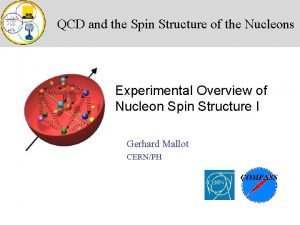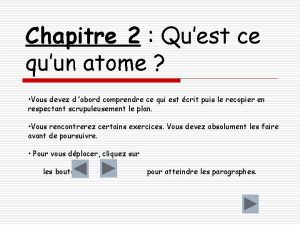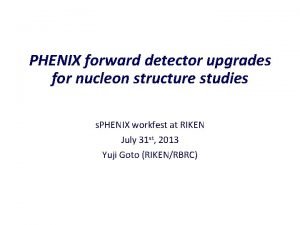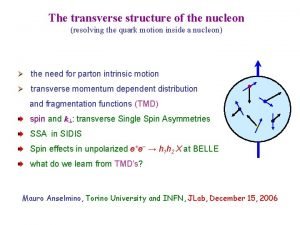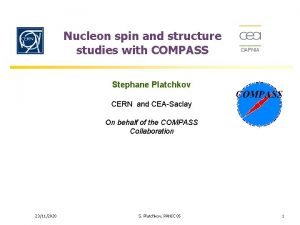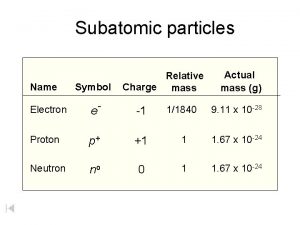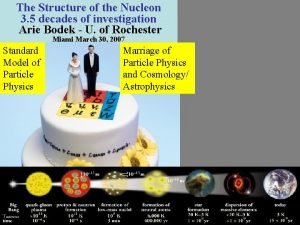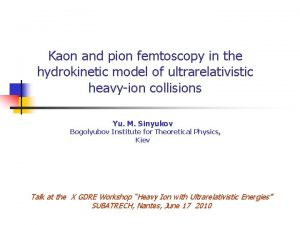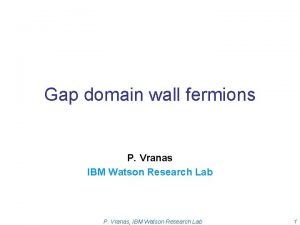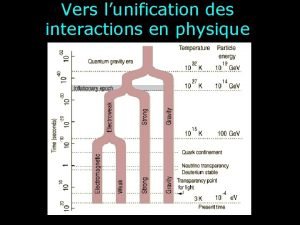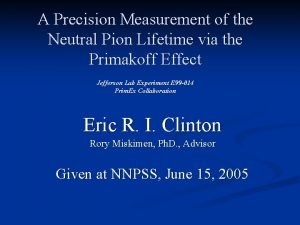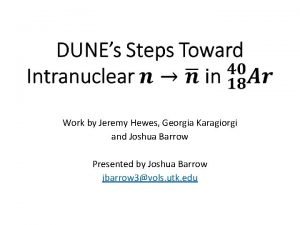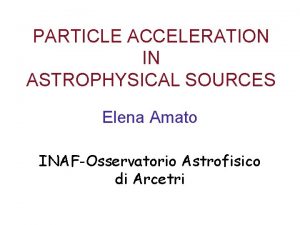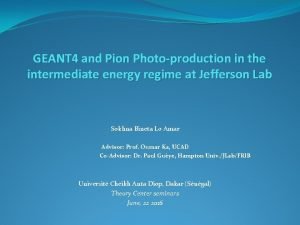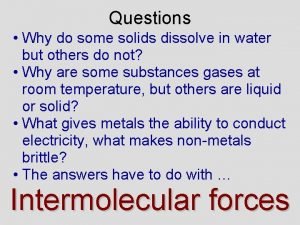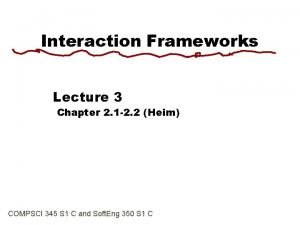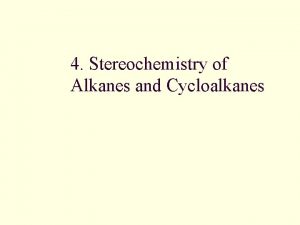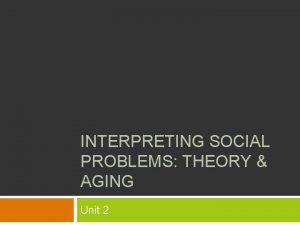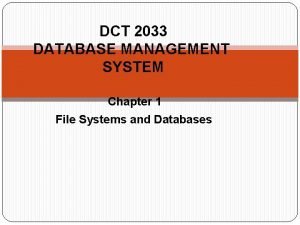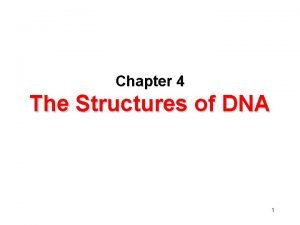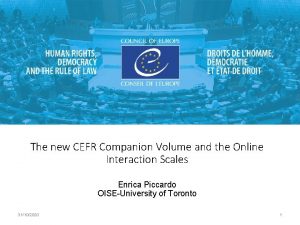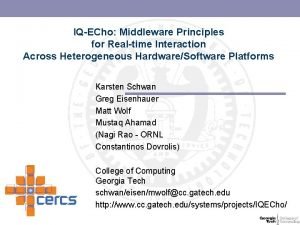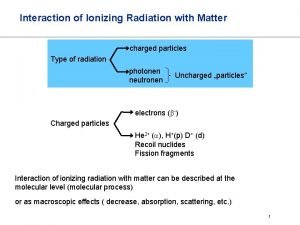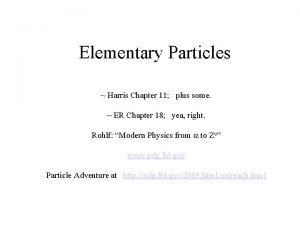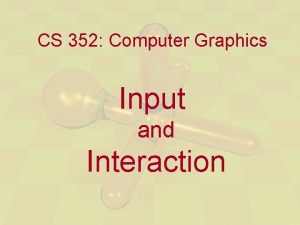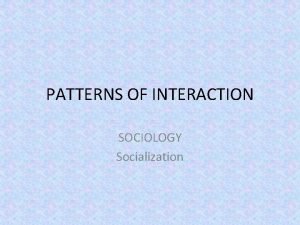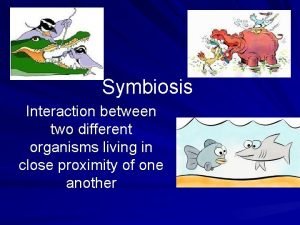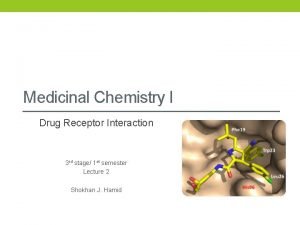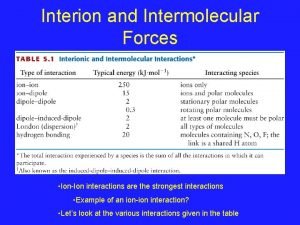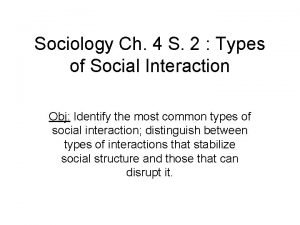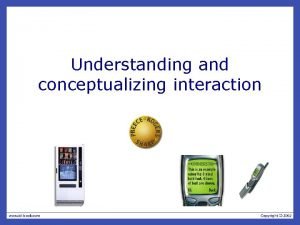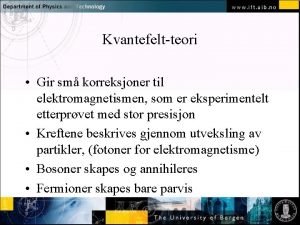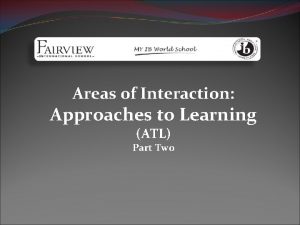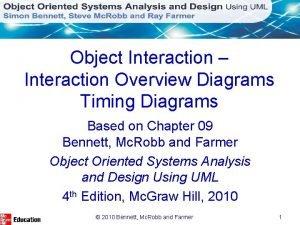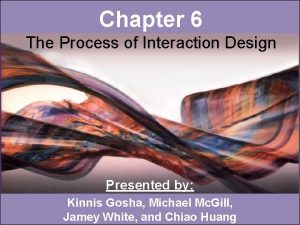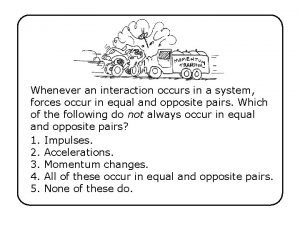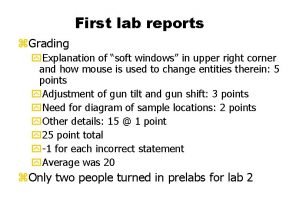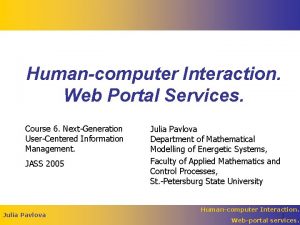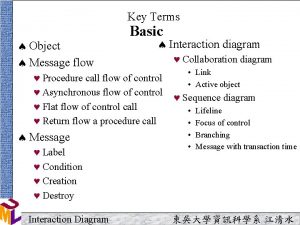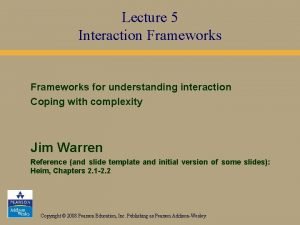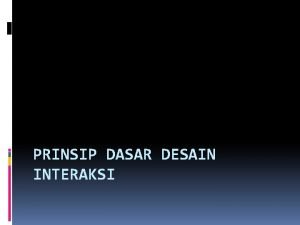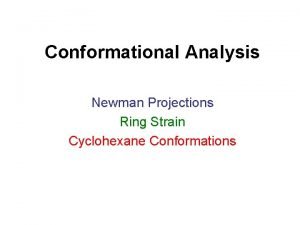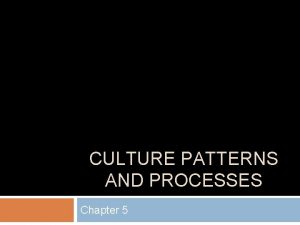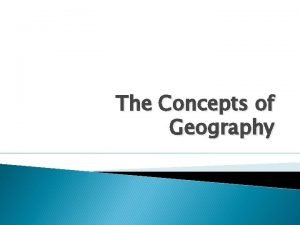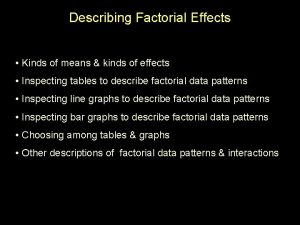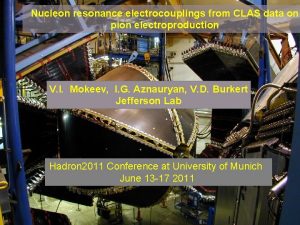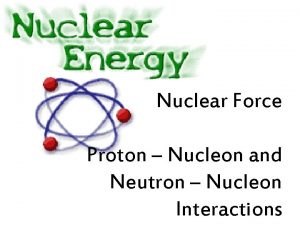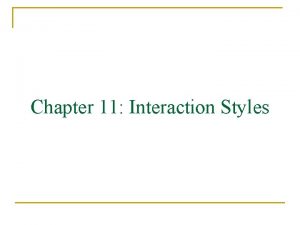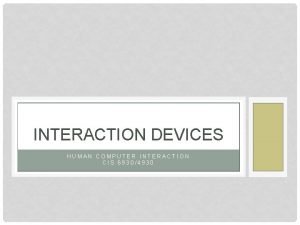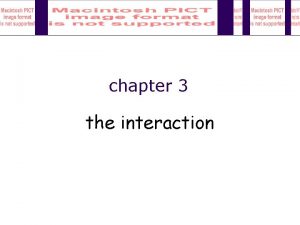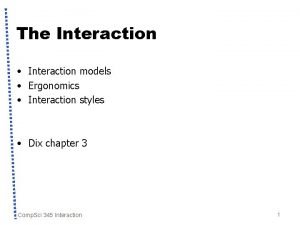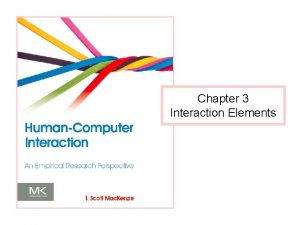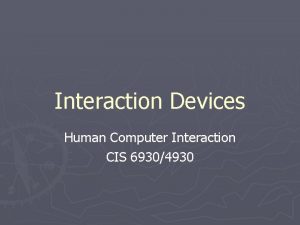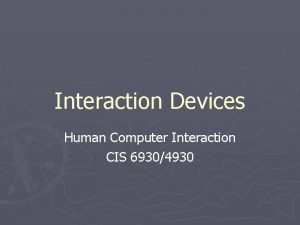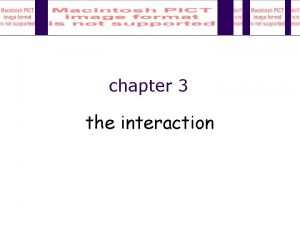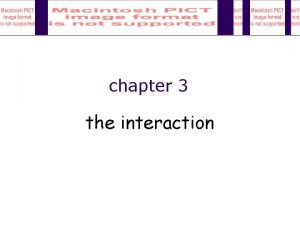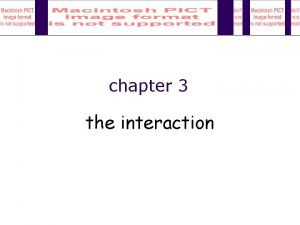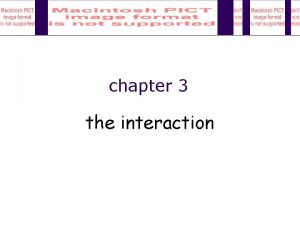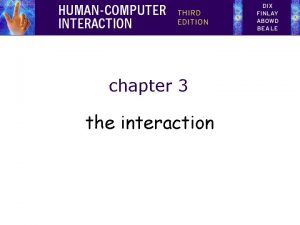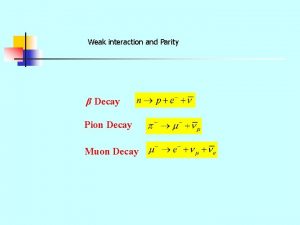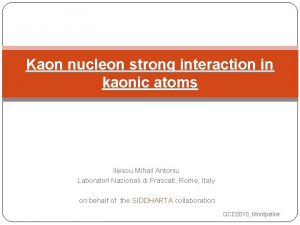Pion nucleon interaction Pion nucleon N interaction is




















































![a+ and a- in units of [10 -3 mπ-1] 1 s = - 7. a+ and a- in units of [10 -3 mπ-1] 1 s = - 7.](https://slidetodoc.com/presentation_image/c39605a5663dc559210ac842cbb284ef/image-53.jpg)















- Slides: 68

Pion nucleon interaction Pion nucleon (πN) interaction is an example for the application of an effective field theory (EFT) here: chiral perturbation theory ΧPT in its twofold meaning: • It deals with mesons and baryons instead of quarks • It is effective in the sense of being efficient Much of the development of ΧPT has its roots historically in the study of the πN interaction → highly advanced both in experiment as well as in theory. ΧPT and related subjects had been subject of many ZUOZ schools (1972 -2000): Straumann, Scheck, Leutwyler, Gasser, Sainio, Kambor, …. Also: Menu 1999 (Zuoz). L. Simons, Zuoz summer school 2006

Outline • Topics in πN physics <-> scattering lengths/volumes • Connection χPT • Meson-Baryon (πN ) observables : ↔ πN (historical development) scattering experiments exotic atoms experiments L. Simons, Zuoz summer school 2006

Topics in πN interaction : • Extension of soft pion theorems (Goldberger Treiman, Weinberg-Tomozawa, etc. . ) with χPT • isospin (non)conservation • σπN -term • πNN coupling constant L. Simons, Zuoz summer school 2006

Scattering lengths: notation scattering amplitudes T: Pion energy < 80 Me. V: Scattering lengths (volumes) al Pion momentum q ->0: ------------------------------------------A+ : π+p -> π+p ↔ a 3/2 A- : π-p -> π-p ↔ (2 a 1/2+a 3/2)/3 A 0 : π-p -> π0 n ↔ - 21/2 (a 1/2 -a 3/2)/3 Höhler‘s notation: Isospin triangle: A+ - A- = 21/2 A 0 π+p -> π+p ~ a+- a- a+0+ ≡ a+ = 1/3(a 1/2+2 a 3/2) isoscalar (: isospineven) π-p -> π-p a-0+ ≡ a- = 1/3 (a 1/2 -a 3/2) isovector (: isospinodd) π-p -> π0 n ~ a + + a~ a- L. Simons, Zuoz summer school 2006

Scattering lengths (volumes) • πNN coupling constant: gπNN Strength of coupling of a pion to a nucleon. Obtainable from a- (isovector) + GMO sumrule • N gπNN fπ N Isospin (non) conservation Difference in quark masses + Coulomb effects Obtainable from π+ p, π-p scattering (isospin triangle); pionic deuterium atom • Pion nucleon σ-term: σπN Response of the nucleon mass to a change in the quark masses. strange quark content of the nucleon Obtainable from πN scattering lengths(volumes) L. Simons, Zuoz summer school 2006

Historical overview * Pre QCD: PCAC: Lead to first ideas for chiral symmetry. App. I Axial current would be conserved if mπ =0 Goldberger Treiman: Links weak and strong interaction terms under the assumption mπ = 0. Valid on the % level → corroborates assumption mπ =0 App. II * Based mainly on review articles by St. Scherer, J. Gasser, H. Leutwyler cited in the appendices as well as A. Thomas, W. Weise, The Structure of the Nucleon, WILEY-VCH 2000 L. Simons, Zuoz summer school 2006

Historical development ctd. QCD: Massless quarks lead to chiral symmetry which in turn would require a parity doubling of hadronic states: not observed in nature. App. III Symmetry is hidden (spontaneously broken) ↔ Goldstone theorem applies: 1: massless particle exist with quantum numbers of the field 2: Its coupling to the current does not vanish GOR relation, chiral condensate, App. IV Cf. σ-term physics Isospin symmetry breaking The most general chiral invariant Lagrangian leads e. g. to PCAC; Including the mass term provides predictive power App. V, VI L. Simons, Zuoz summer school 2006

EFT to higher orders („True“ EFT) S. Weinberg, Physica 96 A (1979)327 Phenomenological Lagrangians, (from chapter: current algebra without current algebra). . . phenomenological Lagrangians themselves can be used to justify the calculation of soft-pion matrix elements from tree graphs, without any use of operator algebra. This remark is based on a „theorem“, which as far as I know has never been proven, but which I cannnot imagine could be wrong. The „theorem“ says. . . This can be put more precisely in the context of perturbation theory: if one writes down the most general possible Lagrangian to any given order of perturbation theory, the result will simply be the most general possible S-matrix consistent with analyticity, perturbative unitarity, cluster decomposition and the assumed symmetry principles. As I said, this has not been proved, but any counterexamples would be of great interest, and I do not know of any. H. Leutwyler, Annals Phys. 235 (1994) 165 On the foundations of chiral perturbation theory Abstract: The properties of the effective field theory relevant for the low energy structure generated by the Goldstone bosons of a spontaneously broken symmetry are reexamined. It is shown that anomaly free, Lorentz invariant theories are characterized by a gauge invariant effective Lagrangian, to all orders of the low energy expansion. The paper includes a discussion of anomalies and approximate symmetries, but does not cover nonrelativistic effective theories. L. Simons, Zuoz summer school 2006

Higher orders ctd. J. Gasser and H. Leutwyler, Annals Phys. 158, 142 (1984); Nucl. Phys. B 250, 465(1985) The work of Gasser, Leutwyler is the basis for a renormalizable EFT: chiral perturbation theory (CHPT or χPT). It used a path integral representation of the QCD generating functional and introduced external fields (vμ, aμ , s, ps-fields). Expansion in powers of external momenta and quark masses. The renormalization constants of Leff are the so-called LEC constants to be determined from experiment or lattice QCD or. . L. Simons, Zuoz summer school 2006

Topics in πN interaction : Low energy scattering experiments • Extension of soft pion theorems (Goldberger Treiman, Weinberg-Tomozawa, etc. . ) with χPT • isospin (non)conservation • σπN -term • πNN coupling constant L. Simons, Zuoz summer school 2006

Some of next slides from R. Meier‘s talk at „Graduiertenkolloquium Basel-Tübingen“ Basel 2003 L. Simons, Zuoz summer school 2006

The pion nucleon σ term L. Simons, Zuoz summer school 2006

L. Simons, Zuoz summer school 2006

Data base suboptimal: CHAOS @ TRIUMF, LEPS, CEX @PSI L. Simons, Zuoz summer school 2006

Extension of data base with CHAOS/TRIUMF Physics Letters B 633 209 (2006) L. Simons, Zuoz summer school 2006

L. Simons, Zuoz summer school 2006

L. Simons, Zuoz summer school 2006

L. Simons, Zuoz summer school 2006

Drastic improvement of low energy scattering data base CHAOS: H. Denz et al. Phys. Lett. B 633, 299 (2006) Up to now a qualitative statement only: L. Simons, Zuoz summer school 2006

L. Simons, Zuoz summer school 2006

L. Simons, Zuoz summer school 2006

L. Simons, Zuoz summer school 2006

Polarized target at PSI L. Simons, Zuoz summer school 2006

Background suppression Focal plane spectrum 1. without constraint 2. -4. with increasing size of active target signal. π+ scattering at Tπ = 68. 6 Me. V, θcm = 81. 3° L. Simons, Zuoz summer school 2006

L. Simons, Zuoz summer school 2006

CEX experiment at PSI: isospin violation W. R. Gibbs et al. Phys. Rev. Lett. 74 3740 (1995) E. Matsinos, Phys. Rev. C 56 3014 (1997) Isospin breaking of about 7% in s-wave amplitudes near Tp=50 Me. V Suspicion: Charge exchange reaction may be the culprit (particularly scarce data base) L. Simons, Zuoz summer school 2006

L. Simons, Zuoz summer school 2006

Transmission technique to measure CEX total cross section: Ti/T 0 = exp-(αiσi) ; α: thickness; i: C, CH 2 Features: Detection efficiency monitored > 99% Targets interchanged every 20 -30 minutes, equivalent Carbon amount measurements at two different beams at PSI Checks with positive pions (as well as muons/electrons: zero result) L. Simons, Zuoz summer school 2006

Main results: Discrepancy between two previous transmission experiments resolved. Isospin symmetry breaking smaller than assumed by Gibbs, Matsinos, but still existing L. Simons, Zuoz summer school 2006

Topics in πN interaction : Experiment with exotic atoms: pionic hydrogen and deuterium • Extension of soft pion theorems (Goldberger Treiman, Weinberg-Tomozawa, etc. . ) with χPT • isospin (non)conservation • σ πN –term: needs scattering volume not provided by πp, πd • πNN coupling constant L. Simons, Zuoz summer school 2006

Pionic hydrogen experiment at PSI Deser-Trueman formula S. Deser et al. . Phys. Rev. 96, 774 (1954) G. Rasche and W. S. Woolcock, NP A 381 405 (1982) Ε 1 s ≈ 7 e. V Γ 1 s ≈ 1 e. V E 1 s: e. m. binding energy of ground state: 3238 e. V r. B : Bohr radius pionic hydrogen: 222. 56 fm Q 0 : kinematic factor: 0. 142 fm-1 P : Panofsky ratio: 1. 546± 0. 009 δε, Γ: e. m. corrections: under debate Goals: 1 s 1 s a + a– (a– )2 0. 2% 1% Debrecen – Coimbra – Ioannina – Jülich – Leicester – Paris – PSI - Vienna H. -Ch. - Schröder et al. , Eur. Phys. J. C 21, 473 (2001): 1 s =-7. 105± 0. 013 stat. ± 0. 034 syst. , 1 s =0. 868± 0. 04 stat. ± 0. 038 syst. e. V L. Simons, Zuoz summer school 2006

Motivation? S. Weinberg, Phys. Rev. Lett. 17, 616 (1966) Y. Tomozawa, Nuovo Cimento A, 707, (1966) : 79 [10 -3 mπ-1] L. Simons, Zuoz summer school 2006

Higher orders E. Jenkins and A. V. Manohar, Phys. Lett. B 255, 558(1991) : HBCHPT T. Becher and H. Leutwyler, JHEP 0106, 017(2001): manifestly Lorentz invariant ππ : expansion to 6 th order in chiral dim. (no. of derivatives and/or quark masses) πN : expansion to 4 th order in chiral dim. L pp = L (2) pp + 2 L (4) pp + L( 6 ) pp 7 53 Number of LEC (1 ) (2) (3) (4) Lp N = L p N + L p N 2 7 23 118 Number of LEC L. Simons, Zuoz summer school 2006

N. Fettes and U. G. Meissner, Nucl. Phys. A 676, 311 (2000) 2. order 3. order 4. order 1. order 3. order; 4. order vanishes exactly Bernard, Kaiser, Meissner Phys. Rev C 52, 2185 (1995) L. Simons, Zuoz summer school 2006

Principle of the X-ray experiment at PSI ultimate energy resolution spherically bent Bragg crystal position & energy resolution background reduction analysis of hit pattern high stop density by high X - ray line yields bright X - ray source L. Simons, Zuoz summer school 2006

Spherically curved Bragg crystal 100 mm R = 3 m Large - Area Focal Plane Detector CYCLOTRON TRAP one coil removed cooling (LN 2) storage area = 26 ns beam iron yoke 109 /s flexible boards image area X - rays CRYOGENIC TARGET pixel size 40 m N. Nelms et al. , Nucl. Instr. Meth 484 (2002) 419 L. M. Simons, Hyperfine Interactions 81 (1993) 253 L. Simons, Zuoz summer school 2006

Arrangement cyclotron trap II X-ray tube more pions/muons ECR - source crystal spectrometer cryogenic target 0 – 40 stp H 2 spherically bent crystals CCD X-ray detector 2 3 matrix 75 50 mm 2 PSI experiment R-98. 01. 1 Debrecen – Ioannina – FZ Jülich – Paris – PSI – IMEP Vienna – ETH Zürich L. Simons, Zuoz summer school 2006

L. Simons, Zuoz summer school 2006

„Trivial“ difficulties • Statistics: cyclotron trap (6) + spherically bent crystals (3 -4) Up to now 68000 events accumulated ( 12 ) • Background : New CCD detectors + much improved shielding (10) In green: improvement factors compared to PSI experiment ETHZ-Neuchâtel-PSI Small fit range: → error in Γ (~ 100 me. V too small) Width: 12 e. V ETHZ-Neuchâtel-PSI Width: 72 e. V R 98 -01. 1 From Monte Carlo simulation: Fit error for this spectrum is 12% From Monte Carlo simulations: Fit error is 5% L. Simons, Zuoz summer school 2006

Less trivial : line shape There are Lorentzian tails in the response function. ΔΓ/Γ < 1% requires a good knowledge of the resp. fct. : Needed: > 30000 events + „no“ background. Previous experiment (calibration Be-1400 cts): ΔΓ/Γ = 8% Present experiment: First round ( πC-4500 cts): ΔΓ/Γ =3. 5% Lorentzian like tails! ↓ ↓ L. Simons, Zuoz summer school 2006

First trial: response function via exotic atoms CH 4 1500 mbar @ T = 295 K C(5 g-4 f) - @ 2974 e. V Drawback: missing intensity quartz 10 -1 = 478 29 me. V (FWHM) Si 111 = 504 16 me. V (FWHM) L. Simons, Zuoz summer school 2006

PSI ECRIT - Electron – Cyclotron – Resonance Ion Trap FIRST PLASMA INSIDE HEXAPOLE large mirror ratio Bmax / Bmin ! argon / oxygen (1/9) 1. 4 10 -6 mbar HF 6. 4 Ghz L. Simons, Zuoz summer school 2006

ECRIT and CRYSTAL SPECTROMETER crystals silicon 111 quartz 10 -1 aperture CCD detector L. Simons, Zuoz summer school 2006

ECRIT measurements 2004 M 1 transitions in He-like S Cl Ar H(2 p-1 s) H(3 p-1 s) H(4 p-1 s) 2 3 S 1 1 1 S 0 M 1 transition = 10 – 8 s 30000 events in line tails can be fixed with sufficient accuracy L. Simons, Zuoz summer school 2006

Show stopper? πp NOT formed in vacuum! Theoretical input: V. M. Markushin PSI T. S. Jensen PSI/Paris V. Popov, V. Pomerant‘sev Moscow State University "dangerous" processes 1. [( pp)p]ee – molecule formation („DH“) ? significant radiative decay modes ? had 2. Coulomb - de-excitation ! non radiative process ni nf + kinetic energy Doppler broadening had L. Simons, Zuoz summer school 2006

Strategy of shift measurement: density dependence mixture H 2 / 16 O 2 (98%/2%) 85 K at 1. 2 bar 4 bar equivalent density H 2 20 K at 2 bar 28. 5 bar equivalent density H 2 17 K at 1 bar LH 2 first time L. Simons, Zuoz summer school 2006

H(3 p-1 s) energy no density dependence identified R-98. 01 LH 2 Maik Hennebach, thesis Cologne 2003 1 s = - 7. 120 0. 008 0. 009 e. V previous experiment EQED = ± 0. 006 e. V ! P. Indelicato, priv. comm. previous experiment – Ar K ETHZ-PSI H. -Ch. Schröder et al. Eur. Phys. J. C 1(2001)473 ! D prediction radiative decay from molecule increases ! T “ " " dominates L. Simons, Zuoz summer school 2006

Stategy of width measurement: different initial states not corrected for Coulomb de-excitation + C Response fct. ETHZ-Neuchatel-PSI 1 s < 850 me. V Maik Hennebach, thesis Cologne 2003 PEAK-TO-BACKGROUND ratio improved by one order of magnitude ! L. Simons, Zuoz summer school 2006

Proof for deceleration process from a different PSI experiment! ( –H)n + H=H ( –H)n-1 + H + kinetic energy NEUTRON - TOF ( – p)ns 0 n A. Badertscher et al. , Eur. Phys. Lett. 54 (2001) 313 n – TOF / ns non-radiative transitions quasi-discrete velocity profile L. Simons, Zuoz summer school 2006

Kinetic energy distributions (Cascade theory) Fit results without Doppler effect Boxes: 0 -2 e. V 2 -20 e. V 29 -33 e. V 65 -75 e. V 210 -220 e. V 2→ 1 Si 111 10 b 1170± 60 me. V Fit results including boxes with FREE weights 907± 34 me. V 250 e. V Boxes: 0 -2 e. V 2 -20 e. V 29 -33 e. V 65 -75 e. V 3→ 1 Si 111 10 b 1053± 40 me. V 775± 40 me. V 100 e. V 4→ 1 Boxes 0 -2 e. V 3 -15 e. V 27 -34 e. V Si 111 10 b 899± 50 me. V 50 e. V 812± 60 me. V 1 s 823 19 me. V (2. 3%) L. Simons, Zuoz summer school 2006

Muonic hydrogen: assumptions about cascade supported Coulomb de-excitation ¬ low-energy component ¬ intermediate-energy component ¬ high-energy component triplet / singlet = 3. 02 0. 2 ----- crystal response ECRIT 2004 HFS splitting: 191± 2 me. V (cf. 184. 6 me. V) L. Simons, Zuoz summer school 2006

1 s = - 7. 120 0. 008 0. 006 e. V ( 0. 2%); 1 s = 823 19 me. V (2. 3%) ε 1 s : Extraction of scattering lengths dominated by PT correction = (-7. 2 2. 9)% * J. Gasser et al. , Eur. Phys. J. C 26, 13 (2003) a++a- = (93. 2± 2. 9) [10 -3 mπ-1] result 2005: 1 s = 823 19 me. V (2. 3%) PT correction preliminary = (0. 6± 0. 2)% * P. Zemp, hadatom 05 a- = (86. 4 +0. 099 -1. 02 ) [10 -3 mπ-1] a+ = (6. 8± 3. 1) [10 -3 mπ-1] * δε depend on three LEC: c 1, f 2; f 1 badly known, depends on f 2 only L. Simons, Zuoz summer school 2006
![a and a in units of 10 3 mπ1 1 s 7 a+ and a- in units of [10 -3 mπ-1] 1 s = - 7.](https://slidetodoc.com/presentation_image/c39605a5663dc559210ac842cbb284ef/image-53.jpg)
a+ and a- in units of [10 -3 mπ-1] 1 s = - 7. 120 0. 008 0. 006 e. V ( 0. 2%) 1 s = 823 19 me. V ( 2. 3%) Adapted from: St. Scherer, Advances in Nucl. Physics. 27, 277 (2003) ; hep-ph/0210398 Experiment R 98 -01. 1 W-T a+ a- a+ =+(6. 8± 3. 1) a- = (86. 4 ± 1) 0 79 HBCh. PT O(p 4) I Fet(00) -9. 6 90. 29 HBCh. PT O(p 4) II Fet(00) +4. 5 77. 03 HBCh. PT O(p 4) III Fet(00) +2. 7 86. 7 RCh. PT O(p 4) Bec(01) -8. 4 ↔-13. 1 91. 41 Fet(00): N. Fettes and U. -G. Meissner, Nucl. Phys. A 676, 311 (2000) KA 85, Matsinos, VPI/GW 98 Bec(01): T. Becher and H. Leutwyler, JHEP 0106, 017 (2001) KA 85 L. Simons, Zuoz summer school 2006

Pion nucleon coupling constant GMO sum rule M. L. Goldberger, H. Miyazawa, R. Oehme Phys. Rev. 99, 986 (1955) J J = -(1. 082± 0. 032)mb T. E. O. Ericson et al. Phys. Rev. C 66, 014005(2002) f 2πN = 0. 5712 a—[mπ] +0. 02488 J[mb-1] gπNN = 0. 0763(+9, -10) = 47. 66 fπN = 13. 165(+0. 077, -0. 087) [ g 2πNN /4π=13. 79± 0. 164 0. 180 ] L. Simons, Zuoz summer school 2006

From M. Sainio‘s talk, Meson Nucleon 99 ZUOZ, πN Newsletter 15, 156 (1999) f 2πN I 0. 0763(+9, -10) J. J. de Swart et al, Proc. Of MENU 97, TRIUMF Report TRI-97 -1, 96 (1997) L. Simons, Zuoz summer school 2006

Recent publications VPI-GWU Analysis (FA 02) http: //gwdac. phys. gwu. edu/ R. Arndt et al. Phys. Rev. C 69, 035213 (2004) GMO NOT used!!! a- = (88. 3± 0. 47) [10 -3 mπ-1] ; gπNN = 13. 145± 0. 048* (constrained by earlier PSI result) No constraints: gπNN = 13. 08; claimed to be robust D, V. Bugg, Eur. Phys. J C 33, 505 (2004) GMO NOT used a- = (85. 0 (Fit I)to 86. 6 (Fit II)) [10 -3 mπ-1] ; gπNN : 13. 09 to 13. 168 T. E. O. Ericson et al. Phys. Lett. B 594, 76 (2004) Analysis of earlier PSI result, GMO sum rule USED a- = (88. 39± 0. 3) [10 -3 mπ-1] gπNN = 13. 28± 0. 08 M. Döring et al. (nucl-th/0402086): a- = (88. 1± 0. 48) [10 -3 mπ-1] * SP 06 nucl-th/0605082: gπNN = 13. 149± 0. 005 !! L. Simons, Zuoz summer school 2006

So what? I. Goldberger Treiman relation: gπNN = MNGA/ Fπ(1+ΔGT) ; ΔGT ≈ mq ΔGT= c M 2π + O(M 4π ), c ≈1/Ge. V 2; T. Becher, hep-ph/0206165 ΔGTtheor ≈ 2% R 98 -01. 1: gπNN ≈ 13. 165; together with MNGA/ Fπ ≈ 12. 9 ΔGTexp. = 2. 05(+0. 60, -0. 67)% II. values for LEC‘s Induced pseudoscalar coupling constant g. P (muon capture: least well known) V. Bernard, N. Kaiser, U. -G. Meissner, Phys. Rev. D 50, 6899 (1994) N. Kaiser, Phys. Rev. C 67, 027002 (2003) <r. A>2: axial radius of nucleon (0. 44± 0. 02) fm 2 With gπNN from R 98 -01. 1: g. P=8. 3± 0. 07 L. Simons, Zuoz summer school 2006

III. S-wave electric dipole multipoles E in charged pion photoproduction: Corrections to LET (Kroll-Ruderman) to O (mπ3) V. Bernard, N. Kaiser, U. -G. Meissner, Phys. Lett. B 383, 116 (1996) „BKM“ V. Bernard, Proc. of Chiral Dynamics 1997, Mainz, Springer Lecture notes in Physics 513, (Springer, Berlin, 1998) hep-ph/9710430 With gπNN = 13. 165 : Values in units of [10 -3 mπ-1] LET BKM DA* Experiment E thr 0+ (γp→π+n) 27. 3 27. 9± 0. 6 27. 99 28. 06± 0. 27 stat. ± 0. 45 syst. ** Ethr -31. 4 -32. 4± 0. 6 -31. 7 -31. 5± 0. 8 *** 0+ (γn→π-p) * „Dispersion theor. analysis“ O. Hanstein et al, Phys. Lett. B 399, 13 (1999) ** E. Korkmaz et al. , Phys. Rev. Lett. 18, 3609 (1999) *** M. A. Kovash et al. , πN Newsletter 12, 55 (1997) Independently: (a-)2=q/ko P │(Ethr With R 98 -01. 1 value of a-: Ethr 0+ 0+ (π-p))│2 ; q, k 0 CMS momenta of γ, π (π-p) = -32. 46± 0. 39 [10 -3 mπ-1] L. Simons, Zuoz summer school 2006

Pionic deuterium ↔ Pionic hydrogen: isospin breaking? Starting point: a+ is small (pion does NOT scatter); Consequences for pionic deuterium scattering length: Exp. : Re aπd=-(0. 0261± 0. 0005) Mπ-1 π-p→ π-p π-n→ π-n π-p→ π0 n c 1, f 2 rather well known, f 1 is the problem f 1 (c 1 known) Combination πH, πD: values for a MUST overlap L. Simons, Zuoz summer school 2006

Last remarks Scattering data await a proper phase shift analysis before σ-term problem can be settled. Isospin breaking still an item gπNN: overall agreement Pionic hydrogen/deuterium have (almost) reached the desired precision, Still hampered by molecular effects. Even now: important constraint. Nuclear physics at low energies (light nuclei) is nowadays on a firm theoretical basis L. Simons, Zuoz summer school 2006

Appendix I: Pions and PCAC * Consider pion decay matrix element for decay: π → μ + ν: <μν│H│π> = <0│Jhadron│π> <μν│jlepton│0> • • jlepton has V-A structure → hadron part should be V or A or both, must be constructed from kinematical quantities q = kν+pμ : <0│Jhadron│π> = i fπq Pion pseudoscalar (o -), → (parity) Jhadron is an axial vector Aλ(0): axial current Translational invariance: <0| Aλ(x) |π(q)> = <0| Aλ(0) |π(q)> exp (-iqx) = i fπ q exp (-iqx) L. Simons, Zuoz summer school 2006

Appendix I ctd. Question: Is the axial Current conserved (CAC valid)? Would require ∂μ<0| Aλ(x) |π(q)> = exp (-iqx) fπ m 2π = 0 ? Answer: If mπ → 0, then YES mπ= 0. 15 mproton : rather small CAC is almost valid: PCAC Zuoz (5. -15. 4. 1972) : Spring school on weak interactions and nuclear structure, talk by N. Straumann: . . . Many theoreticians nowadays idealize strong interaction physics by lettering mπ 0. In this limit the axial current could also be conserved(chiral symmetry). As long as SIN has not yet produced any pions, we should, however, better not consider them as being massless. * Literature: e. g. U. Mosel: Fields, Symmetries and Quarks, Springer 1988 L. Simons, Zuoz summer school 2006

Appendix II: Goldberger Treiman relation * CAC would be valid for mπ → 0, which are the consequences for neutron decay ? Axial part of the matrix element for neutron β decay: n(p) →p(p’)+ e + ν; Tranlational invariance: <p´│Aλ(x)│p> = <p´│Aλ(0)│p> exp(-iqx) , q=p´-p <p´│∂λAλ(x)│p> =-i(p´-p) <p´│Aλ(0)│p> exp(-i(p´-p)x) Symmetry considerations: Assume CAC: 2 MN F(q 2)+q 2 G(q 2)=0, MN: nucleon mass ⇓ Goldberger Treiman relation F(q 2) → fπ , G(q 2)→GA gπNN = MNGA/ fπ is valid on the % level Question: CAC, CVC seem to be established, how to implement this in QCD? Answer: A chiral symmetric Lagrangian for QCD can be constructed for quark masses mq=0. i. e. invariant against chiral transformation ↓ Noether’s theorem Vector and Axial Vecor currents are conserved for mq=0 * Literature E. D. Commins & P. H. Bucksbaum, Weak interactions of leptons and quarks L. Simons, Zuoz summer school 2006

Appendix III: Chiral symmetry and its consequences * Lagrangian density of QCD : quark- gluon part mu/Mp⋍0. 005 md/Mp⋍ 0. 01 ms/Mp⋍ 0. 2 L 0 has an extra symmetry related to conserved right- or left-handedness (chirality) of zero mass spin ½ particles. One introduces right- and left-handed quark fields: Separate global unitary transformations of these fields leave L 0 invariant. Right- and left-handed components of massless quark fields do not commute. SU(3)Rx. SU(3)L transformations leave the Lagrangian L 0 invariant, this is called: Chiral symmetry of QCD ⇩ Noether’s theorem Conserved currents L. Simons, Zuoz summer school 2006

Appendix III ctd. Assumption: The axial and vector charges are conserved , they commute with the hamiltonian H 0 = HQCD(mq=0) [H 0, QV, a]=0= [H 0, QA, a] Eigenstates: H 0 │ψ> = E │ψ> Then the states QV, a│ψ> and QA, a│ψ> have the same energy but they should have opposite parity. Meson and baryon mass spectra show: this is NOT the case! Way out: Q A, a│0> ≠ 0 The ground state does not have the symmetry of the Lagrangian. Chiral symmetry is hidden (spontaneously broken). Goldstone’s theorem applies: 1: massless particle exist with quantum numbers of the field 2: Its coupling to the current does not vanish : <0| Aλ(0) |π(q)> = i fπ qμ ≠ 0 To summarize: Q A, a│0> ≠ 0 Q V, a│0> = 0 Axial vector symmetry is spontaneously broken. 8 massless Goldstone particles are associated with the axial charges: (π, K, η). They are not exactly massless as Lmass is not chirally invariant. Vector symmetry not broken spontaneously. Hadrons occur in nearly degenerate multiplets which constitute representations of SU(3)V. * Literature: J. Gasser, Light quark dynamics hep-ph/0312367 Part ic have le states much o diffe f opposi te rent mass parity es ! Graphs taken from: A. Hosaka, H. Toki, Quarks, Baryons and Chiral Symmetry, World Sc. 2001 L. Simons, Zuoz summer school 2006

Appendix IV: Chiral condensate, GOR relation, Isospin breaking * Finite value of mπ from explicit breaking of chiral symmetry by quark masses. Calculating the divergence of Noether currents ( only flavour part u, d ) from the variation of results in e. g. St. Scherer hep-ph/0210398 Using PCAC results in: explicit spontaneous symmetry breaking Mass term: Chiral symmetry * Isospin symmetry breaking. Literature: Conference contributions by H. Leutwyler (especially hep-ph/9409423) L. Simons, Zuoz summer school 2006

Appendix V: Lagrangian of lowest order (Goldstone bosons only) * The most general, chirally invariant, Lagrangian density with a minimal number of derivative (equivalent to the „nonlinear σ model) reads: • Leff is invariant under the global SU(3)Lx. SU(3)R transformations U→ RUL† • F 20/4 is chosen to generate the standard form of the kinetic term ½ ∂ μ Φa • Axial vector Noether current : PCAC * Literature: St. Scherer, in Advances in Nuclear Physics, Vol 27, 277 (2003), hep-ph/0210398 L. Simons, Zuoz summer school 2006

Appendix VI: Including the mass term * Including the mass term even provides predictive power (see below): From this expression soft pion theorems can be derived. It may be considered to be the starting point of „true“ effective theories i. e. of a Lagrangians leading to renormalizable solutions and containing higher orders. For Leff above: : Mass formulae of Gell-Mann Okubo can be derived GOR relation is readily obtained: M 2=(mu+md)B B is proportional to the quark condensate: It is the leading order parameter of the spontaneously broken chiral symmetry. Corroborated by Kl 4 decays in terms of the isoscalar scattering length a 00 S. Pislak et al. Phys. Rev. Lett. 87 (2001) 221801. G. Colangelo, J. Gasser, and H. Leutwyler, Phys. Rev. Lett 86 (2001) 5008 * Monograph by St. Scherer (hep-ph/0210398) L. Simons, Zuoz summer school 2006
 Qcd
Qcd Couche electronique
Couche electronique Nucleon
Nucleon Nucleon
Nucleon Nucleon
Nucleon Nucleon number
Nucleon number Nucleon
Nucleon Pion
Pion Pion diamonds
Pion diamonds Louis pion montre
Louis pion montre Pion lifetime
Pion lifetime Georgia karagiorgi
Georgia karagiorgi Elena amato
Elena amato Pion geant
Pion geant Dipole induced dipole interaction
Dipole induced dipole interaction Interaction model in distributed system
Interaction model in distributed system Abowd and beale framework examples
Abowd and beale framework examples Sector d group chapter 3
Sector d group chapter 3 What is a gauche interaction
What is a gauche interaction Problems with conflict theory
Problems with conflict theory Dbms manages the interaction between
Dbms manages the interaction between Stacking interaction in dna
Stacking interaction in dna Companion volume with new descriptors
Companion volume with new descriptors Realtime interaction
Realtime interaction Ionizing radiation
Ionizing radiation Modelling rich interaction
Modelling rich interaction Area of interaction
Area of interaction Interaction hypothesis long
Interaction hypothesis long Competitive interaction
Competitive interaction Electroweak interaction
Electroweak interaction Role strain
Role strain Interaction in computer graphics
Interaction in computer graphics Mean girls sociology
Mean girls sociology Two different organisms living together
Two different organisms living together Teaching interaction procedure
Teaching interaction procedure Types of living organisms
Types of living organisms Drug receptor interaction medicinal chemistry
Drug receptor interaction medicinal chemistry Ion-dipole interaction example
Ion-dipole interaction example Social interaction cooperation
Social interaction cooperation Ic business manager reports
Ic business manager reports Social process that gets things done.
Social process that gets things done. Interaction styles in hci
Interaction styles in hci Group dynamics and communication
Group dynamics and communication Electroweak interaction
Electroweak interaction Area of interaction
Area of interaction The interaction diagrams, use case diagrams are called as
The interaction diagrams, use case diagrams are called as Interaction overview diagram
Interaction overview diagram Four basic activities of interaction design
Four basic activities of interaction design Icons in hci
Icons in hci An interaction occurs whenever
An interaction occurs whenever Iatf clauses
Iatf clauses Definition of hei in geography
Definition of hei in geography Richer interaction in hci
Richer interaction in hci Interact
Interact Interaction volume
Interaction volume Rome human environment interaction
Rome human environment interaction Interaction web portal
Interaction web portal Message flow diagram
Message flow diagram How do these screen objects afford
How do these screen objects afford Cycle interaction framework
Cycle interaction framework Interaction design basics
Interaction design basics Online communication rules
Online communication rules Newman projections of cyclohexane
Newman projections of cyclohexane Socialization is a lifelong process.
Socialization is a lifelong process. Palin pci training
Palin pci training Relocation diffusion def
Relocation diffusion def H-bonding intermolecular forces
H-bonding intermolecular forces Spatial interaction ap human geography
Spatial interaction ap human geography How to know if there is a main effect
How to know if there is a main effect
